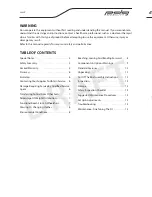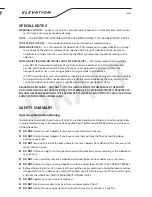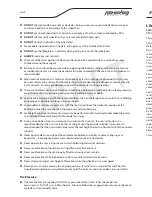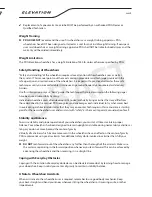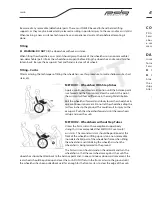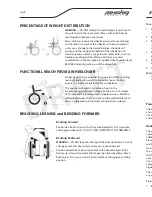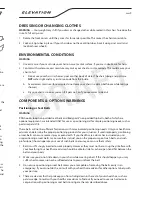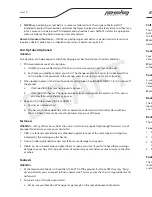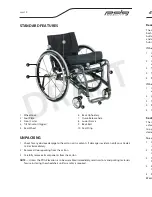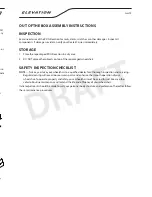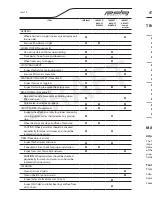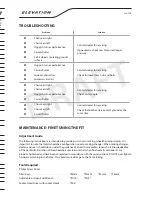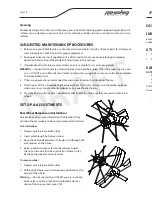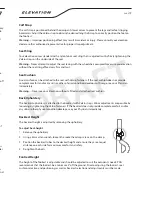
DRAFT DRAFT
page
24
page
5
4
Replacement of a pneumatic tire or tube MUST be performed by an authorized PDG Dealer or
Qualified Technician.
Weight Training
6
PDG DOES NOT
recommend the use of its wheelchairs as a weight training apparatus. PDG
wheelchairs have NOT been designed or tested as a seat for any kind of weight training. If occupant
uses said wheelchair as a weight training apparatus, PDG shall NOT be liable for bodily injury and the
warranty will be voided immediately.
Weight Limitation
The PDG Elevation wheelchair has a weight limitation of 250 lb. unless otherwise specified by PDG.
Safety/Handling of Wheelchairs
“Safety and Handling” of the wheelchair requires close attention of the wheelchair user as well as
the assistant. This manual points out the most common procedures and techniques involved in the
safe operation and maintenance of the wheelchair. It is important to practice and master these safe
techniques until you are comfortable in maneuvering around frequently encountered architectural
barriers.
Use this information only as a “basic” guide. The techniques that are discussed on the following pages
have been used successfully by many.
Individual wheelchair users often develop skills to deal with daily living activities that may differ from
those described in this manual. PDG recognizes and encourages each individual to try what works best
in overcoming architectural obstacles that they may encounter. Techniques in this manual are a starting
point for the new wheelchair user and assistant with “safety” as the most important consideration for all.
Stability and Balance
To assure stability and proper operation of your wheelchair, you must at all times maintain proper
balance. Your wheelchair has been designed to remain upright and stable during normal daily activities as
long as you do not move beyond the center of gravity.
Virtually all activities which involve movement in the wheelchair have an effect on the center of gravity.
PDG recommends using seat restraints for additional safety while involved in activities that shift your
weight.
6
DO NOT
lean forward out of the wheelchair any further than the length of the armrests. Make sure
the casters are pointing in the forward position whenever you lean forward. This can be achieved by
advancing the wheelchair and then reversing it in a straight line.
Coping with Everyday Obstacles
Coping with the irritation of everyday obstacles can be alleviated somewhat by learning how to manage
your wheelchair. Keep in mind your center of gravity to maintain stability/balance.
A Note to Wheelchair Assistants
When assistance to the wheelchair user is required, remember to use good body mechanics. Keep
your back straight and bend your knees whenever tilting the wheelchair or traversing curbs, or other
impediments.
ELEvATION WHEELCHAIR TEST CONFIGURATION
Seat Width
650mm
Seat Depth
407mm
Seat Back Height
240mm
Wheelchair Weight
12 kg
Seat sling
Standard Sling Seat w/tension straps
Back Upholstery
Standard back upholstery
Wheels
24” Wire Wheels
Casters
5” Aluminum Soft Roll
Footrest
Aluminum Footrest
Other Options
None
Mass of ATD
115 kg
Max. User Weight
115 kg/250 lbs
DIMENSIONAL AND PERFORMANCE ATTRIBUTES OF THE TEST
WHEELCHAIR
Feature
Min
Max
Overall length with legrest
815 mm
876 mm
Overall width
587 mm
688 mm
Total mass
12.0 kg
12.0 kg
Static stability downhill
>10°
>10°
Static stability uphill
5.4°
7.6°
Static stability sideways
>10°
>10°
Seat plane angle
12.0°
n/a
Effective seat depth
356 mm
457 mm
Effective seat width
356 mm
457 mm
Seat surface height at front edge
485 mm
515 mm
Backrest angle
-14.5°
+48.0°
Backrest height
240 mm
370 mm
Footrest to seat distance
385 mm
425 mm
Leg to seat angle
80 mm
105 mm
Hand-rim diameter
520 mm
572 mm
Minimum turning radius
515 mm
515 mm
The Elevation wheelchair conforms to the test methods for static, impact and fatigue strengths as
required by ISO 7176-8.


